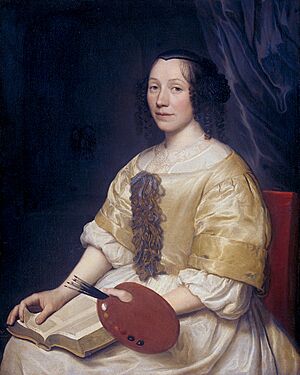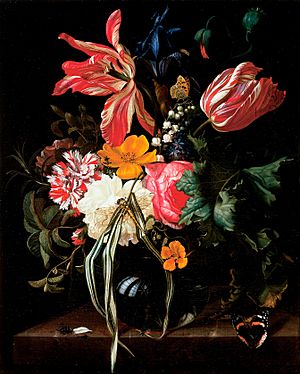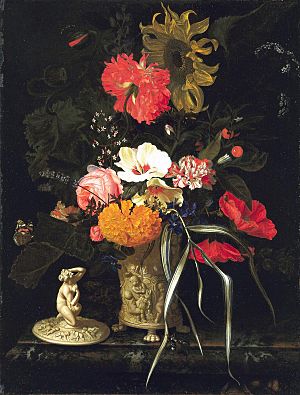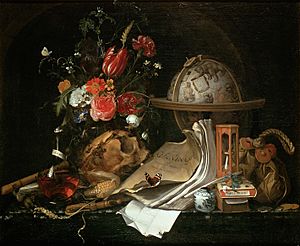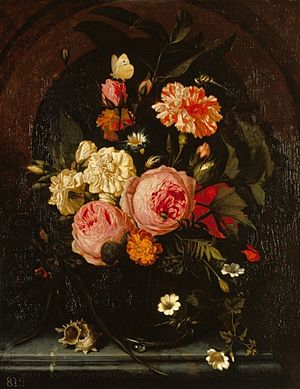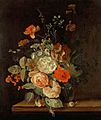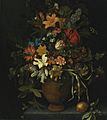Maria van Oosterwijck facts for kids
Maria van Oosterwijck (1630–1693) was a famous Dutch Golden Age artist. She was known for her very detailed paintings of flowers and other still lifes.
Contents
Maria van Oosterwijck's Life as an Artist
Maria van Oosterwijck was born in 1630 in Nootdorp, a town in the Netherlands. Her father was a minister, and he took her to the studio of a great still life painter, Jan Davidsz. de Heem. This visit sparked Maria's interest in painting flowers.
Early Training and Moving Cities
Maria became a student of Jan Davidsz. de Heem. She quickly showed a great talent for painting realistic and colorful scenes. She first worked in Delft and then moved to Utrecht.
When her teacher, de Heem, moved to Antwerp, Maria had a chance to paint on her own. She later moved to Amsterdam in the 1670s. Her art studio was across from another flower painter, Willem van Aelst.
Dedication to Art and Business Success
Willem van Aelst wanted to marry Maria, but she said no. She was so dedicated to her painting that it was more important to her than marriage. Maria stayed single her whole life. She did, however, raise her nephew, who had lost his parents.
Maria was not just a talented painter; she was also a smart businesswoman. She hired an agent in Amsterdam to help sell her paintings to people in Germany.
Famous Customers and Challenges
Many important people bought her artwork. These included Louis XIV of France, the Holy Roman Emperor Leopold I, Augustus II the Strong, and William III of England. She even sold three paintings to the King of Poland.
Even though her flower paintings were very popular, Maria was not allowed to join the painters' guild. This was because women were not permitted to join at that time. Very few women were professional artists in the 1600s.
Portraits and Teaching Others
In 1671, the artist Wallerant Vaillant painted a portrait of Maria. It showed her holding a painting palette in one hand and a Bible in the other. This showed her skill as a painter and her religious beliefs.
Another portrait, possibly by Gerard de Lairesse, shows Maria with the poet Dirk Schelte. In 1673, Schelte wrote a poem praising Maria's beautiful paintings and her good character.
Maria also taught her servant, Geertgen Wyntges, how to mix paints and become a painter. After Maria passed away, Geertgen became an independent artist and supported herself with her painting.
Later Life and Legacy
Maria van Oosterwijck created her last known painting in 1689. It was a still life called Still Life with Flowers, Insects and a Shell. This painting is now in the Royal Collection at Kensington Palace in London.
She died in 1693 at her home in Uitdam, a town near Amsterdam. The art biographer Arnold Houbraken praised Maria van Oosterwijck. However, he did not consider her a "professional artist," even though her paintings sold for very high prices to kings and queens.
Maria van Oosterwijck's Art Style and Meaning
Maria van Oosterwijck painted flower scenes and still lifes that often had hidden meanings. These types of paintings were very popular in Europe during her time. She and Rachel Ruysch were considered the best still life painters in the Low Countries.
Painting Techniques and Details
Maria's artwork used bright, glowing colors and was full of rich details. She sometimes used a technique called chiaroscuro, which means using strong contrasts of light and shadow. She often painted dark backgrounds, which made the objects in the front look even brighter.
She helped change how floral still lifes were painted. She made them look very realistic, similar to the "trompe-l'œil" style from the 16th century, which means "to trick the eye." Not many of her paintings still exist today, but most of them are flower pieces. Many of her paintings were small. This was common for artists then, as smaller pieces were easier to sell to more people.
Symbolism in Her Paintings
Maria's paintings often included symbolic items. These symbols reflected common ideas in 17th-century Dutch still life art. Themes included how short life is, how things don't last forever, and the importance of being devoted to God.
Her "vanitas" paintings included objects that reminded people that life is temporary. These objects might be hourglasses, books, insects, or wilting flowers. She also included symbols of new life, like butterflies. This gave her work a gentle, thoughtful feeling.
Religious Meanings and Hidden Butterflies
Maria van Oosterwijck was very religious. She often put her strong beliefs into her paintings using symbols. For example, a sunflower turning towards the light symbolized turning towards God. Grapes had a religious meaning because they are used to make eucharistic wine. Even colors had meaning: white for innocence, yellow for holiness, and red for sacrifice.
Maria often included a special detail in her still lifes: a red admiral butterfly. This butterfly appears in many of her larger paintings. Sometimes it's on a flower stem, or on the edge of a table. The butterfly helped draw the viewer's eye into the painting. It also symbolized Christ's resurrection.
Where to See Her Art (Collections)
You can find Maria van Oosterwijck's paintings in museums around the world, including:
- Cincinnati Art Museum
- Crocker Art Museum (Sacramento, California)
- Denver Art Museum
- Fitzwilliam Museum (Cambridge)
- Kunsthistorisches Museum (Vienna)
- Mauritshuis (The Hague)
- Palatine Gallery in Palazzo Pitti (Florence)
- Royal Collection (London)
- Statens Museum for Kunst (Copenhagen)
Gallery
See also
 In Spanish: Maria van Oosterwijck para niños
In Spanish: Maria van Oosterwijck para niños


